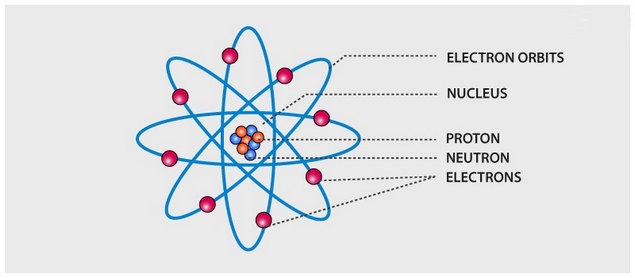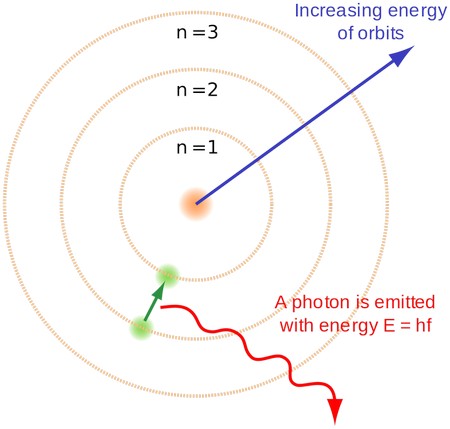The Elecron is a subatomic particle whose electric charge is negative one elementary charge Electrons belong to the first generation of the lepton particle family,and are generally thought to be elementary particles because they have no known components or substructure.The electron has a mass that is approximately 1/1836 that of the proton. Quantum mechanical properties of the electron include an intrinsic angular momentum (spin) of a half-integer value, expressed in units of the reduced Planck constant, Being fermions, no two electrons can occupy the same quantum state, in accordance with the Pauli exclusion principle.Like all elementary particles, electrons exhibit properties of both particles and waves: they can collide with other particles and can be diffracted like light. The wave properties of electrons are easier to observe with experiments than those of other particles like neutrons and protons because electrons have a lower mass and hence a longer de Broglie wavelength for a given energy.

Electrons play an essential role in numerous physical phenomena, such as electricity, magnetism, chemistry and thermal conductivity, and they also participate in gravitational, electromagnetic and weak interactions.Since an electron has charge, it has a surrounding electric field, and if that electron is moving relative to an observer, said observer will observe it to generate a magnetic field. Electromagnetic fields produced from other sources will affect the motion of an electron according to the Lorentz force law. Electrons radiate or absorb energy in the form of photons when they are accelerated. Laboratory instruments are capable of trapping individual electrons as well as electron plasma by the use of electromagnetic fields. Special telescopes can detect electron plasma in outer space. Electrons are involved in many applications such as electronics, welding, cathode ray tubes, electron microscopes, radiation therapy, lasers, gaseous ionization detectors and particle accelerators.

Interactions involving electrons with other subatomic particles are of interest in fields such as chemistry and nuclear physics. The Coulomb force interaction between the positive protons within atomic nuclei and the negative electrons without, allows the composition of the two known as atoms. Ionization or differences in the proportions of negative electrons versus positive nuclei changes the binding energy of an atomic system.
Fof more info please visit the wikipedia.org
Subatomic particle
In the physical sciences, subatomic particles are particles that are smaller than atoms.These may be composite particles, such as the neutron and proton; or elementary particles, which according to the standard model are not made of other particles.Particle physics and nuclear physics study these particles and how they interact.The concept of a subatomic particle was refined when experiments showed that light could behave like a stream of particles (called photons) as well as exhibiting wave-like properties. This led to the concept of wave–particle duality to reflect that quantum-scale particles behave like both particles and waves (they are sometimes described as wavicles to reflect this citation needed]). Another concept, the uncertainty principle, states that some of their properties taken together, such as their simultaneous position and momentum, cannot be measured exactly.The wave–particle duality has been shown to apply not only to photons but to more massive particles as well. Interactions of particles in the framework of quantum field theory are understood as creation and annihilation of quanta of corresponding fundamental interactions. This blends particle physics with field theory.

All observable subatomic particles have their electric charge an integer multiple of the elementary charge. The Standard Model's quarks have "non-integer" electric charges, namely, multiple of 1/3e, but quarks (and other combinations with non-integer electric charge) cannot be isolated due to color confinement. For baryons, mesons, and their antiparticles the constituent quarks' charges sum up to an integer multiple of e.
Through the work of Albert Einstein, Satyendra Nath Bose, Louis de Broglie, and many others, current scientific theory holds that all particles also have a wave nature. This has been verified not only for elementary particles but also for compound particles like atoms and even molecules. In fact, according to traditional formulations of non-relativistic quantum mechanics, wave–particle duality applies to all objects, even macroscopic ones; although the wave properties of macroscopic objects cannot be detected due to their small wavelengths. Interactions between particles have been scrutinized for many centuries, and a few simple laws underpin how particles behave in collisions and interactions. The most fundamental of these are the laws of conservation of energy and conservation of momentum, which let us make calculations of particle interactions on scales of magnitude that range from stars to quarks. These are the prerequisite basics of Newtonian mechanics, a series of statements and equations in Philosophiae Naturalis Principia Mathematica, originally published in 1687.
Subatomic particle : detailed specification and data
SAFETY WARNINGS
Terrain specified in the header corresponds to the real situation in terrain of the cache placement. Please consider your options, capabilities weather conditions. Remember that the safety is in first place in all circumstances. All you are doing is on your own risk, the author assumes no responsibility. Please protect the nature.
BEZPEČNOSTNÍ UPOZORNĚNÍ
Terén uvedený v záhlaví odpovídá skutečnému uložení krabičky a proto prosím zvažte vaše možnosti, schopnosti, povětrnostní podmínky. Pamatujte že bezpečnost je až na prvním místě. Kešku lovíte na vlastní nebezpečí, autor nenese žádnou odpovědnost. K přírodě se chovejte ohleduplně a neničte ji.
Thank DDM Vracov Geocaching club for the BETA test and help with the installation.
You guys are really awesome team :)